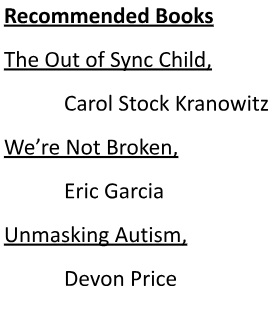Autism Spectrum Disorder (ASD) is a developmental disability caused by differences in the brain. People with ASD often have problems with social communication and interaction, and restricted or repetitive behaviors or interests. People with ASD may also have different ways of learning, moving, or paying attention.
High -Functioning Autism Spectrum Disorder (HFASD)- Adolescents and Adults with ASD who do not have intellectual impairment or disability.
AD(H)D– is marked as an ongoing pattern of inattention and or hyperactivity-impulsivity that interferes with functioning or development. ADHD is one of the most common neurodevelopmental disorders of childhood. Children with ADHD may have trouble paying attention, controlling impulsive behaviors (may act without thinking about what the result will be), or be overly active
According to the scientific literature, 50% to 70% of individuals with ASD also present with comorbid ADHD
More than half of all individuals who have been diagnosed with ASD also have signs of ADHD. In fact, ADHD is the most common coexisting condition in children with ASD.
ADHD can mask autism. For those who have both conditions, it’s more common for the autism diagnosis to come much later compared to those that have only autism. This is likely due to ADHD symptoms presentations masking the autistic behaviors.
How are ADHD and Autism similar?
Both are neurodevelopmental conditions
Both are likely to display an intense interest in certain topics or hobbies
Both adversely affect executive functioning skills
Both may cause a difficulty with interpersonal relationships
How are autism and ADHD different?
Autistic individuals can have a strict reliance on routines, while ADHD can have a distaste for routines, as well as a tendency to not follow through
Interpersonal relationship difficulties are most likely caused by a deficit in social skills for autistic individuals; while people with ADHD more likely struggle with interpersonal relationships because of impulsive behaviors
Those with autism are more likely than ADHDers to have more severe challenges with social cues and nonverbal communications
Developmental milestones are more commonly reached at the expected age in children with ADHD alone, compared to those with autism
ASD-Social Interaction:
Impairment of two-way interaction
Resistance to change; inflexible
Misses social cues
Has different concept of “friend”
Lacks inhibition
May isolate himself socially
Social environment will cause frustration which can lead to explosive outbursts
Social Communication:
Odd, pedantic speech, superficial
Lacks expression/ can not discern different tones of voice
Face blindness
Very literal understanding
Poor non-verbal communication
Fails to grasp implied meanings
Can’t flirt
Social Imagination:
Difficulty with transitions/changes
No imaginative play
Insists on routines- No Surprises
Difficulty transferring skills from one setting to another
All absorbing interest
Anxiety:
Anxiety is as important an issue in the daily life of ASD individuals as are social difficulties. In fact, anxiety adds to social difficulties which, in turn, effects anxiety. This greatly influences negative behavior.
Telltale signs of ASD:
Can’t abstract- can’t read between the lines, black/white thinking
Poor eye contact
Can’t lie
Poor fine motor ability
Visual thinking, yet poor imagination
Facial expression does not match feelings
Non flexible thinking
Stimming
Co-morbidity:
Motor clumsiness- sign of ADHD
Sensory Overload- too much/too little
Mind blindness-
being blind how others feel or think
no insight
Central Coherence Deficit-
can’t see forest, just trees
can’t see pieces fitting together to create a picture or scenario
Executive Function Deficit- It can affect memory, attention, thinking, planning, organizing, scheduling, problem-solving, and self-monitoring
Executive Function Deficits:
Difficulty with:
Time management
Organization
Planning
Tasks with multiple steps
Initiating
Emotional control
Differential Diagnosis or Co-morbid (exist together)
ADHD
OCD
Generalized Anxiety Disorder (GAD)
Language Processing
Sensory Integration

